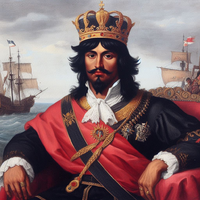Oustec
This article is a work-in-progress because it is incomplete and pending further input from an author. Note: The contents of this article are not considered canonical and may be inaccurate. Please comment on this article's talk page to share your input, comments and questions. |
Kingdom of Oustec | |||||||||||||
|---|---|---|---|---|---|---|---|---|---|---|---|---|---|
| 1566-1859 | |||||||||||||
|
Post-1812 flag | |||||||||||||
| Capital | Various (1566-1812) Oduria (1812-1859) | ||||||||||||
| Religion | Catholic ' | ||||||||||||
| Government | Piratocracy (1566-1812) Absolute monarchy (1812-1859) | ||||||||||||
| King | |||||||||||||
• 1566-1585 | Oustec I | ||||||||||||
• 1840-1859 | Abey III | ||||||||||||
| |||||||||||||
The Kingdom of Oustec was a polity in Vallos that existed from the 16th through 19th century. For most of its history, it was a piratocracy, a type of entity common in contemporary Vallos that existed primarily for the act of oceanic piracy of Levantine trade with Crona. It was established by the famous pirate Oustec, who transitioned from being a wealthy pirate to a powerful political leader as he subjugated various cities, eventually forming the Kingdom with himself as its first King.
History
Formation
Golden age of Vallosi piracy
Decline
Beginning in 1700, Oustec and the other piratocracies entered a period of decline. The reliance of these states on the exponential growth of global trade, and piracy based on that trade, meant that the inevitable slow-down of Levanto-Cronan trade stifled state income. Client obligations within the states, and Oustec especially, outpaced revenues, precipitating a century of domestic turmoil and budgetary shortfalls. Additionally, growing Bergendii power in the Capelranco Archipelago and improved anti-piracy convoys also decreased state revenues.
Reform effort
Beginning in 1812, King Abey II began an ambitious series of reforms to transition the Kingdom from a personalist client-patron piratocratic model into a more traditional, Occidental-style institution-based state. Abey's vision was that Oustec would move to an absolute monarchy, where the crown would serve as the central system of political organization, and that state revenues would be based more on trade duties and internal economic activity rather than the no longer lucrative tradition of piracy. The reforms were partly successful but were resisted both by traditionalists, who sought to maintain Oustec's oceanic orientation, and local powerbrokers who resented efforts to centralize. Significant resistance came from the Harounan Province. Abey sought to balance the Kingdom's armed forces by changing focus from solely privateer-based naval and marine forces to a standing professional land army, and Harounan possessed the best trained and most professional forces in the country. Efforts to centralize its forces led to bitter resentments that would splinter the province from the Kingdom as it faced terminal threats elsewhere.

In an effort to legitimate his realm and his reforms, Abey abandoned the traditional "roving court" seaborn model the Kingdom had employed and established the court at Oduria, a major city and once the seat of a same-named undecimvirate.
Partition
The Odurian War led to the final partition of the Kingdom of Oustec. The war began ostensibly as an intervention into Oustec by Caphiria to protect the community of Latin-speaking cities there. The unification of Burgundie created it as a strong, Levantine colonial power with extensive possessions bordering Oustec. Its presence sparked a period of fear and panic in Caphiria regarding Levantine Creep and the fate of the Latins in the country. The sudden invasion of eastern Oustec on 18 March 1858 prompted a counter-invasion of the rest of the country by Burgundie in July, fearing that Caphiria might annex the entire rump Kingdom. In August, the estranged Harounan Province declared independence from the crumbling Oustec state and sought protection from Urcea, whose forces in New Archduchy were well positioned to arrive at the Harounan Province in a timely manner. The Oustec, unable to resist invasion from three sides, pulled most of their forces back to their inland capital city of Oduria. Oduria was besieged by Burgoignesc forces for much of 1859 before finally falling towards the end of the year. The conflict threatened to escalate into a general conflict involving the three Occidental powers before Kiravia brokered a peace.
Extent
In its earliest formation, Oustec's realm consisted only of islands in the Capelranco Archipelago, but its profound wealth and success allowed it to extend its dominion over mainland Vallos. By 1598, it had conquered modern Arona, establishing what would become its longterm borders.